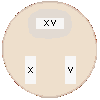CNS Infection - Bacterial IdentificationLaboratory testing algorithm for Neisseria meningitidis, Streptococcus pneumoniae (pneumococcus), Listeria monocytogenes, Hemophilus influenzae, E. coli, Group B Streptococcus, Staphylococcus aureus, and Pseudomonas aeruginosa Hover over the animation to start / stop rotationGram Negative Cocci - - Growth in High CO2Large Colonies on Chocolate AgarGlucose Positive - - Maltose Positive    Neisseria meningitidis Neisseria meningitidisGram Positive DiplococciCatalase NegativeAlpha hemolysis on blood agarOptochin Sensitive    Streptococcus pneumoniae (pneumococcus) Streptococcus pneumoniae (pneumococcus)Small Gram Positive Rods - Tumbling MotilityGrowth: Wide Temperature RangeCatalase PositiveSmall Pale Colonies - Beta Hemolysis    Listeria monocytogenes Listeria monocytogenesSmall Gram Negative CoccobacilliGrowth on Chocolate AgarHemin (X factor) and NAD (V factorRequired for Growth on Nutrient Agar    Haemophilus influenzae Haemophilus influenzaeLarge Gram Negative RodsMacConkey Agar - Positive LactosePositive Indole - - Green Sheen on EMB Agar     Escherichia coli Escherichia coliGram Positive Cocci in ChainsCatalase NegativeCAMP Test Positive withBeta Hemolysis on Blood Agar    Group B Streptococcus(S. agalactiae) Group B Streptococcus(S. agalactiae)Gram positive Cocci in ClustersCatalase Positive - - Coagulase Positive    Staphylococcus aureus Staphylococcus aureusLarge Gram Negative RodsBlood Agar Beta Hemolysis, Metallic SheenOxidase PositiveLactose Negative, Greenish Pyocyanin PigmentMueller-Hinton Agar Blue-green Pigment     Pseudomonas aeruginosa |


